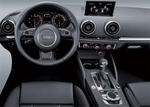
Audi has launched a diesel version of the A3 - the 2010 Audi A3 1.6 TDI - which outputs just 99 g/km of CO2. The fuel consumption of the 2010 Audi A3 1.6 TDI is rated at 3.8 liters of diesel per 100 km (61.90 US mpg). The 2010 Audi A3 1.6 TDI is powered by a 1,598 cc four-cylinder TDI engine which develops 77 kW (105 hp) at 4,400 rpm and 250 Nm (184.39 lb-ft) of torque between 1,500 and 2,500 rpm. The 3-door version of the 2010 Audi A3 1.6 TDI is able to accelerate from 0 to 100 km/h in 11.4 seconds with a maximum speed of 190 km/h. The Sportback version of the 2010 Audi A3 1.6 TDI needs 11.7 seconds to get from 0 to 100 km/h.
The company says the 2010 Audi A3 1.6 TDI price will be in the same segment as its competitors and that the new model will become available in the first half of 2010.
Audi Press Release:
Audi has once again raised the efficiency bar: the new A3 1.6 TDI emits just 99 grams of CO2 per kilometer (159.33 g/mile) — thus undercutting the threshold of 100 g/km (160.93 g/mile). This corresponds to astounding fuel efficiency of 3.8 liters of diesel per 100 km (61.90 US mpg). At the same time, this TDI engine generates 77 kW (105 hp) of output and 250 Nm (184.39 lb-ft) of torque, for powerful propulsion.
The new models in the A3 series are powered by a four-cylinder TDI, which delivers 77 kW (105 hp) at 4,400 rpm from a displacement of 1,598 cc and — between 1,500 and 2,500 rpm — steadily transmits 250 Nm (184.39 lb-ft) of torque to the crankshaft. The TDI propels the three-door A3 from 0 to 100 km/h (0 to 62.14 mph) in 11.4 seconds and on up to a top speed of 190 km/h (118.06 mph); the A3 Sportback reaches 100 km/h in 11.7 seconds.
The exemplary fuel efficiency of 3.8 liters of diesel per 100 km (61.90 mpg) is largely due to the synergetic impact of technologies from Audi’s
modular efficiency platform. The start-stop system turns the engine off as soon as the vehicle comes to a stop, the shift lever is in neutral, and the driver has removed their foot from the clutch pedal. Start-stop then turns the engine back on as soon as the clutch pedal is depressed — all the while functioning quietly, conveniently, and quickly.
During braking and coasting phases, the energy-recovery system intelligently controls the alternator to recover energy, which is temporarily stored in the battery. This energy is then fed
back into the electrical system during acceleration — thus reducing the load on the alternator. That saves fuel. The energy-recovery system and the start-stop system unleash their full potential under city-driving conditions — precisely where most customers drive every day.
Both new models in the A3 series roll off the assembly line with manual five-speed transmissions featuring a final drive ratio longer by some seven percent. A gear-change indicator in the instrument cluster helps the driver to select the ideal gear. This solution is key, as about 30 percent of fuel consumption depends on a given driver’s decisions and driving style.
The new Audi A3 1.6 TDI models with 99 g CO2/km boast even more innovations from Audi’s Modular Efficiency Platform. The vehicle’s body is slightly lower to the ground. This reduces the frontal area and — in conjunction with specially designed elements on the body and the underbody — aerodynamic drag, as well. The 195/65 R 15 tires excel via especially low rolling resistance.
Audi will begin selling the A3 1.6 TDI and the A3 Sportback 1.6 TDI in the first half of 2010. Prices will be similar to those models already on the market which offer the same performance.











